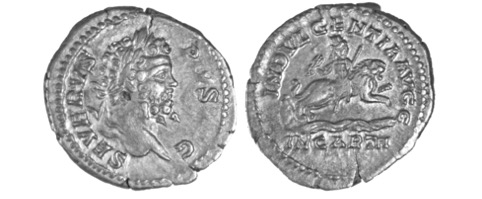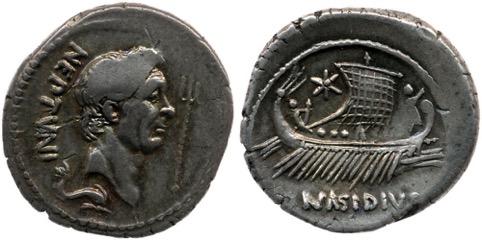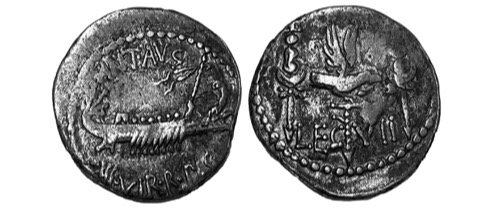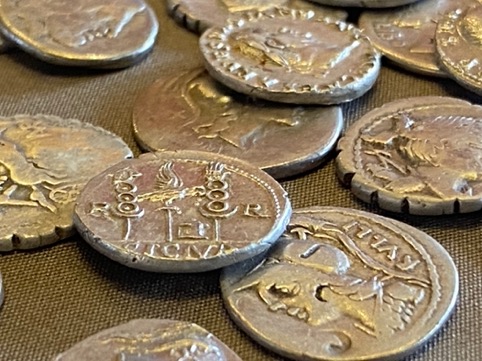Antony's Legionary Denarii, by Campbell Orchard
When one thinks of the coins of the Roman Empire, ordinarily it is of a coin with the emperor’s visage on the obverse (heads), and an imperial or religious image on the reverse (tails) (Fig. 1). One also thinks of those famous Romans who steered the empire and made an impact on its history — figures such as Caesar, Augustus, Nero, and so on. However, whilst coins minted under these emperors were indeed prolific, Marc Antony’s legionary series somehow outlasted them all.
 |
| Fig. 1. RIC IV 193. Denarius. Obv: Laureate head of Septimius Severus, right. SEVERVS PIVS AVG. Rev: Dea Caelesris holding thunderbolt and sceptre, riding lion right. INDVLGENTIA AVGG / INCARTH. Photo taken by author. From the University of Warwick Classics Department Collection, 2016.3.9. |
Between 32-31 BCE, Marc Antony’s (83-30 BCE) eastern mints issued a large series of silver denarii in the lead up to the Battle of Actium. There are two theories regarding where these coins were minted: some believe there was a mobile workshop that moved with Antony’s army in northwestern Greece, while others argue the coins were struck at Patras, a port city in Northern Achaea in the Peloponnese, where Antony had his military and naval base.
These coins are commonly referred to as ‘legionary denarii’ for their depiction of legionary standards and legends identifying specific legions and units within Antony’s army. As a result, legionary denarii are popular among collectors, providing an opportunity to not only collect Antony’s legions, but also an interesting historical link to the battle of Actium via the galley on the obverse.
Antony’s legionary denarii are distinguished by their reverence to Antony’s military forces (Fig. 2). Antony’s naval forces are represented by the right facing galley on the obverse, and his land forces are represented by the aquila (legionary eagle-standard) between two other military standards.
The galley on the obverse is ornately decorated, although the decoration varies between coins and likely reflects the artistic freedom of the die engraver. The mast slants forward over the bow. The rudder is depicted to the left and is accompanied by a single bank of oars, which vary between seven and 12 oars on the different dies and denarii in the series (Fig. 2 has 11 oars). The heads of the rowers are visible above the side, with railing to each side. The number of rowers also appears to have been an artistic freedom left to the engraver. A tri-partite ram is attached to the bow of the galley, the depiction of which again varies between different dies. A figurehead is also attached to the bow of the galley; it is difficult to discern but appears crocodilian.
The legend above the ship ANT AVG abbreviates the name Antonius (Antony) along with one of his titles, Augur, a prestigious priestly office of the Roman state. Below the ship is Antony’s other title: III VIR. R.P.C. (tres viri rei publicae constituendae), which states Antony’s position as a “Triumvir for the Reorganisation of the Republic”. The title III VIR was also behind Antony’s authority to raise troops and rule the eastern half of the Empire, hence its prominence on his coinage.
 |
| Fig. 2. RPC 544/25. Denarius. Photo taken by the author from a private NZ collection. |
The reverse side of the coin shows a legion’s eagle (aquila) flanked by two standards. The aquila was sacred to the honour of the legion and its loss in battle was a disgrace (it was a big deal to recover a lost aquila, as seen on the breastplate of the Prima Porta Augustus referencing Augustus’ retrieval of the aquilae lost to the Parthians). A standard bearer (signifer) in each of the legion’s 10 cohorts carried the signum (standard), a pole adorned with metal discs and crescents. As with the obverse, the more general details outside of the overall design appear to have been left to the engraver. For example, the dotted disks on the standards are occasionally depicted as stars. Differences are also quite apparent in the depictions of the eagle, with some appearing squashed, others elongated, and some more naturalistic. The lengths of the poles, which are formed of dots, also varies between coins.
The inscriptions on the reverse of the legionary denarii changes between coins. This either appears across the field of the coin (fig. 2), or clockwise above, naming the legion or cohort being honoured. 23 legions are represented on Antony’s denarii, and two further specialist units (these include longer legends on the top outside of the coin).
The differences in the details in what is otherwise a fairly static series reveals an interesting fact about the production process: that an overall design brief was provided, but that in general, it was left to the die engraver how these elements were depicted. As a result, these depictions should be considered as representations rather than as accurate depictions of how these galleys and military standards may have appeared.
Although Antony’s legionary denarii appear to be a step away from the normal coinage types used in the late Roman Republic, which often propagated the family of the official in charge of the mint, they do in fact have historical roots. The galley prow was an important motif on early Roman coinage and continued to be used occasionally throughout the Republic; Sextus Pompey’s denarii seem to be the most immediate precedent for the legionary denarius galley (Fig. 3). Pompey's power was primarily naval, and this was reflected on his coinage.
 |
| Fig. 3. RRC 483.2.4. Denarius. Obv: Head of Pompey the Great, right. NEPTVNI. Rev: galley sailing right. Q NASIDIVS. From The British Museum, 2002,0102,4693. |
The legionary standards and eagle on the reverse of Antony's coins have also appeared previously as features of coins with military-themed designs. However, the specific arrangement of the standards flanking the eagle alongside the legend representing the military unit is a new development.
Warwick’s own Dr Clare Rowan has suggested Antony’s choice of military themed iconography was a conscious decision intended to counter Octavian's claims that Antony was styling himself as a Hellenistic King (Fig. 4). As a result, the legionary denarii emphasise Antony's role as a Roman commander and his legitimacy as a triumvir of the Republic. The imagery of the galley and the representations of Antony’s legions emphasised the scale and Romanness of his military power.
 |
| Fig. 4. RRC 543.1.1. Denarius. Obv: Head of M. Antonius right. ANTONI ARMENIA DEVICTA. Rev: bust of Cleopatra right, draped and wearing diadem. CLEOPATRAE REGINAE REGVM FILIORVM REGVM. From The British Museum, 1860,0328.21. |
Antony minted a vast quantity of these coins prior to his defeat at Actium. A full-strength legion in this era had about 4,800 men, with standard annual pay for infantry set at 225 denarii. It is impossible to accurately estimate how many of these coins were minted. However, the best estimate is that at least 25 to 35 million coins were struck to cover military expenditure.
To support such a large volume of production, the mint lowered the silver content. Ironically, it was the lower silver content of Antony’s denarii that prolonged their survival. The inclusion of the Marc Antony denarius is not unusual in imperial coin hoards — at the time of minting, this denarius contained 4% less silver than contemporary denarii, with a fineness of 92%, which is fairly comparable with the standards of the following two centuries. As a result, it seems to have remained in common circulation, rather than being re-minted, and many survive only in a highly worn state, as seen by Warwick’s own example (fig. 5).
 |
| Fig. 5. RPC 544/20. Denarius. Photo taken by author. From the University of Warwick Classics Department Collection, 2016.1.1. |
Surviving Antony were his highly recognisable legionary denarii, although they were probably unpopular at the time due to their debasement. They circulated for centuries; meanwhile, the silver content of Rome’s denarii declined to the point that they came to equal the intrinsic value of Antony’s legionary coinage. The denarius under Marc Antony is 92% pure silver, under Vespasian it was 89% pure, under Domitian between 98% and 93% pure, under Trajan 89% pure, and under Antoninus Pius 83% pure. Near the end of Commodus’ reign the denarius dropped to 71% purity. Ongoing debasement essentially increased the value of the legionary denarius over time, and increased its staying power within circulation.
Also check out the numerous examples at Warwick’s Market Museum (fig. 6). The museum has two stunning early imperial hoards on display with large quantities of Roman republican coinage. It’s well worth the visit!
The Classics Department’s example (fig. 5.) will be on display in the antiquity’s cabinet on level 3 of the Faculty of Arts Building for the next month. Go check out this well-travelled piece of history!
 |
| Fig. 6. Photo taken by author and used with permission. From the Warwick Market Museum. |
Bibliography
Bland, R., ed. (1992) Coin Hoards from Roman Britain: The Chalfont Hoard and Other Roman Coin Hoards. Vol. IX. (London: British Museum).
Crawford, M. H. (1974). Roman Republican Coinage. Vols. I-II. London: Cambridge University
Crawford, M. H. (1969). Roman Republican Coin Hoards. London: Royal Numismatic Society.
Harl, K. (1996). Coinage in the Roman Economy. Baltimore.
Lockyear, K. (2007). Patterns and Process in Late Republican Coin Hoards. Oxford: Archaeopress, BAR International Series.
Murphy, N. (2014). A denarius perpetuus? : the circulation of the "legionary denarii" of Marc Antony in Roman Italy and Britain 32-BC-AD 294. University of Warwick.
Rowan, C. (2019). From Caesar to Augustus (c. 49 BC-AD 14) : using coins as sources. Cambridge, United Kingdom: Cambridge University Press. pp. 109–116.
Woytek, B. (2012). ‘The Denarius Coinage of the Roman Republic’ In Metcalf, W. E. (ed.). The Oxford Handbook of Greek and Roman Coinage. Oxford: Oxford University Press. pp. 315–344.
 |
This post was written by Campbell Orchard, a PhD candidate in the Department of Classics and Ancient History at the University of Warwick. Campbell is currently researching the Roman mint of Tarsus in Cilicia. |
 Matthew Evans
Matthew Evans

 Loading…
Loading…
Add a comment
You are not allowed to comment on this entry as it has restricted commenting permissions.